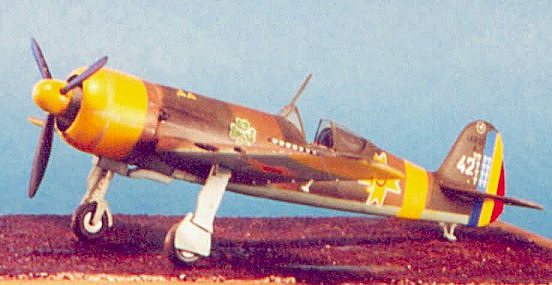
|
KIT: |
LTD 1/48 IAR-80 |
|
KIT # |
9804 |
|
PRICE: |
$14.95 |
|
DECALS: |
Several aircraft |
|
REVIEW & |
|
|
NOTES: |
Short run kit with vac canopy |

|
HISTORY |
The I.A.R. 80 series, the only domestically-designed fighter to see service with the Romanian Air Force, was so obscure that the American P-38 pilots of the 1st and 82nd Fighter Groups who attacked Ploesti on June 10, 1944 and were intercepted by the IAR 80/81s flown by Grupul 6 were certain for more than 30 years that they had faced German pilots in Fw-190s that day. The fact they lost no less than 23 P-38s of 45 fighter bombers from the 82nd FG and a similar number of escorts from the 1st FG was bad enough - that it would be the result of Romanian pilots flying an obsolescent fighter was something difficult for the Americans to accept. This day was in fact the high point of the career of the Romanian fighter.
In 1938, the leaders of the Aeronautica Regala Romana, correctly foresaw war breaking out in the near future, and determined to increase the size of the air force. The Romanians were able to sign contracts with both the Germans and the British for the supply of aircraft modern aircraft, though in limited numbers due to their own rearmament requirements. Previously, the air force had equipped with Polish P.Z.L. fighters, and the P.Z.L.24 - last of the series - was the primary Romanian fighter at the time. British and German deliveries could not meet the need for fighters, and I.A.R.-Brasov, the government aircraft factory, was directed to develop a domestic fighter aircraft. Industria Aeronautica Romana was not a stranger to aircraft design, having created several domestic aircraft previously - but they had yet to try their hands at a fighter. To reduce the technological risk, much of the basic design was taken from the P.Z.L. P.24, with the entire fuselage from the cockpit aft and the tail structure being directly taken from the P.24, while the rest of the design incorporated an all-metal low wing and retractable landing gear, while being powered by the same license-built Mercury that powered the P.24.
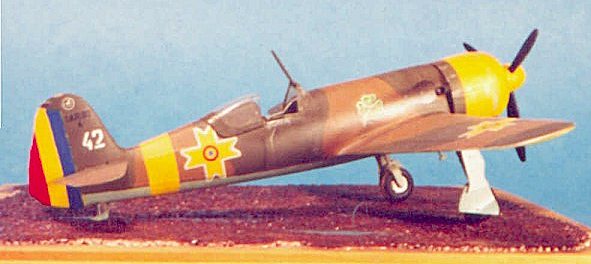 The prototype I.A.R.
80 first flew on April 20, 1939, and surpassed all expectations. 100 of the
fighters were ordered in December 1939, on the successful completion of the test
program. The first 20, however, were not delivered until Decemb er 1940, due to
lack of materials in the factory, unavailability of weapons, repeated
undercarriage failures and engine problems. These aircraft equipped
Escadriles 59 and 60 vanatoare of Grupul 8 vanatoare (8th Fighter
Group).
The prototype I.A.R.
80 first flew on April 20, 1939, and surpassed all expectations. 100 of the
fighters were ordered in December 1939, on the successful completion of the test
program. The first 20, however, were not delivered until Decemb er 1940, due to
lack of materials in the factory, unavailability of weapons, repeated
undercarriage failures and engine problems. These aircraft equipped
Escadriles 59 and 60 vanatoare of Grupul 8 vanatoare (8th Fighter
Group).
The Original I.A.R. 80A was equipped with an armament of four 7.62mm machine guns. The I.A.R. 80B was provided with an additional 2 similar weapons outboard of the original armament.
The I.A.R. 80s of Grupul8 took part in the invasion of the southeastern Soviet Union in June 1941, with Grupul 8 assigned a pure fighter role. Their primary mission was protecting bombers and reconnaissance aircraft. After the first few days of invasion there was an almost-complete lack of Soviet air activity. On July 12, Sublocotenent aviator Vasile Claru of Grupul 8 shot down three of six I-16s, then rammed a fourth after he ran out of ammunition; both aircraft were destroyed and Claru was killed.
As losses mounted in the fall of 1941, more units converted to the I.A.R.80 as resupply by the Germans was unreliable; among those changing were the two squadrons equipped with the Heinkel He-112B, which had suffered lost and damaged aircraft amounting to 45 percent of their strength in the first three months of the war, without any possibility of replacements.
The I.A.R.81 began life as a development of the I.A.R.80 for the dive-comber role. The fighter-bomber version was assigned to Grupul 8 in October 1941 and made their combat debut on October 16 with attacks in concert with German Stukas on Odessa.
In early 1942, all of the units still flying P.Z.L. fighters converted on to the I.A.R. 80, which was the only fighter aircraft available in any numbers. More than 100 I.A.R. 80/81 aircraft were committed to the Stalingrad campaign that year. The Russian counterattack at Stalingrad was initially aimed at the Romanian army forces, and the air force was hard put to support the troops in their retreat during early 1943; 12 I.A.R.80/81s were lost in the counterattack, which began in November 1942.
By 1943, the I.A.R.80 was obsolescent in the face of new Soviet aircraft like the MiG-3 and LaGG-3 fighters. The squadrons that remained in the Soviet Union were re-equipped with Bf-109Gs, while the remaining I.A.R.80 force was returned to Romania for home defense, with Grupul 6 becoming the primary operator of the I.A.R.80.
On August 1, 1943, the Romanians faced "Operation Tidal Wave," the American strike at the Ploesti oil fields. Of 130 B-24s that actually reached the target, 36 fell victim to the air defenses, with ten B-24s claimed by Escadrili flying the I.A.R.80/81s. "Operation Tidal Wave" was a pyrrhic victory for the U.S.A.A.F., with the majority of the refineries resuming operation within a month.
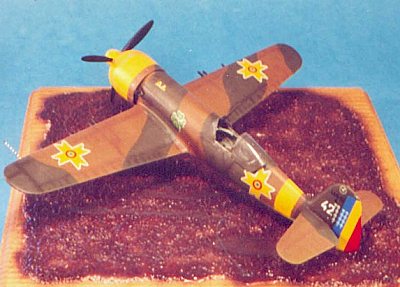 April 4, 1944, saw
the first of a series of American air raids between then and August 1944 that
would see Romania finally surrender to the Allies that September. The I.A.R.
80s would saw a great deal of combat during these raids, as shown by the claim
of 40 B-24 and B-17 aircraft shot down between April 4 and June 6, 1944 by
fighters of Grupul 6.
April 4, 1944, saw
the first of a series of American air raids between then and August 1944 that
would see Romania finally surrender to the Allies that September. The I.A.R.
80s would saw a great deal of combat during these raids, as shown by the claim
of 40 B-24 and B-17 aircraft shot down between April 4 and June 6, 1944 by
fighters of Grupul 6.
As related at the outset, June 10, 1944 was the high point of the combat career of the I.A.R. 80, when Grupul 6 surprised the P-38s of the 1st and 82nd fighter groups at low level approaching Ploesti and shot down 23 while losing only 3 of their own - the blackest day in the histories of both American units, and was the highest single-mission loss for P-38 units of the entire war.
On June 23, the Americans exacted revenge, killing the Grupul 1 commander, Capitan comandor aviator Ion Sandu and two other I.A.R. 80 pilots. On July 3, the Secretary for Air reported total Romanian fighter availability since April 4 had declined from 115 to 50, with 33 pilots killed in action. Citing the inferiority of the I.A.R.80 against the P-51 Mustang, the I.A.R. 80 units were withdrawn from the defense of Bucharest on July 5, 1944 and sent to Moldavia to oppose the invading Soviets.
In late July, Grupul 6 began conversion from the I.A.R.80 to the Bf-109G. During the Soviet offensive into Romania that began August 20, 1944, five I.A.R. 80/81 aircraft were lost by August 24, 1944, when a coup d' etat in Bucharest took Romania out of the war on the Axis side.
57 I.A.R. 80/81 aircraft took part in the anti-German campaign that began September 6, 1944, and the remaining I.A.R. 80s operated as part ofthe joint Soviet-Romanian attack on the remaining German forces in northeastern Romania. Three German Bf-109s were shot down by I.A.R.80 pilots, though the I.A.R 80 was considered incapable of opposing the Bf-109G-6, while 9 were shot down by the Germans during the campaign. By February 1945, the remaining I.A.R.80s, now part of Grupul 9, were operating in Slovakia. By the end of the war in May 1945, the fighters were participating in the capture of Prague.
The I.A.R.80 continued as a first-line figher until 1947, when it and the Bf-109 were replaced by the Lavochkin La-9. The last I.A.R. 80 was struck off charge in 1956.
|
THE KIT |
In 1995, Squadron Shop began offering limited-run kits of "esoteric" aircraft types, with LTD Hobbies of the Czech Republic creating the PZL P.11c, LaGG-3, I.A.R. 80, and CA 13/19 Boomerang. The I.A.R. 80 is representative of the early period of eastern European limited run injection-molded kits, with nice surface detail and thick parts, with "some modeling ability required" to create a model. The kit includes excellent Microscale decals for three aircraft, and two vacuform canopies. Now out of production, I have seen this kit offered on sale by Squadron for US$4.99 on occasion. For the collector of esoteric models, it is no more difficult than a contemporary Classic Airframes kit.
|
CONSTRUCTION |
Construction began by taking all parts off the thick sprues with a razor saw. As with any limited-run kit, all assembly was preceded by test fitting before gluing parts together.
I sanded out the interior of the fuselage in the area of the cockpit, to give a more "scale thickness" look. There is not much information available about the cockpit of the I.A.R. 80, so I fudged things by making rudder pedals and a throttle quadrant, and using the kit parts for the seat, control stick and instrument panel, suitably thinned down. I glued the fuselage together and attached the horizontal stabilizers, then turned to the engine.
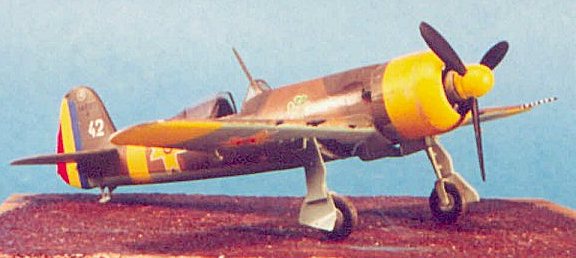 The engine is a pretty
rough approximation of the real item, but once inside the close-fitting cowl and
with the large prop spinner up front, not much can be seen anyway and what is
there looks effective.
The engine is a pretty
rough approximation of the real item, but once inside the close-fitting cowl and
with the large prop spinner up front, not much can be seen anyway and what is
there looks effective.
I thinned down the trailing edges of the wings before assembling them, and boxed in the wheel wells with Evergreen sheet. Once the wings and engine were joined to the fuselage, putty was liberally applied to all joints and sanded down when dry.
When I constructed the landing gear, I thinned down the gear legs with a file, and sanded the gear doors so they were thinner, since all of these were thick parts to begin with.
|
PAINT & DECALS |
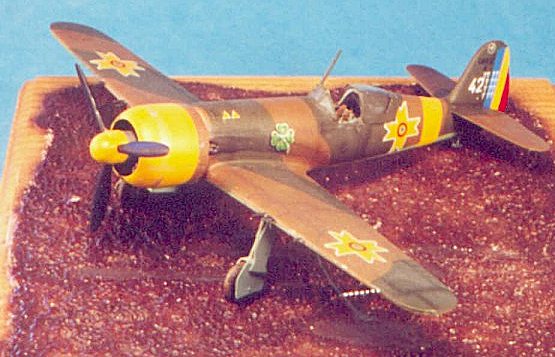 Painting:
Painting:
I followed the very comprehensive painting and markings guide, starting with Tamiya flat yellow for the frontal markings. I masked these off, then painted the lower surfaces with Gunze-Sanyo RLM-65 Hellblau, which is a close approximation of the Romanian sky blue color. I used Gunze-Sanyo British Dark Earth and Dark Green for the upper surface camouflage.
Markings:
I chose to do the I.A.R. 80B flown by Adjutant aviator Florian Budu of Grupul 6 vantoare, one of the top-scoring I.A.R. 80 pilots, who was killed in action on May 31, 1944. The decals are printed by MicroScale and behaved as expected with a coat of Micro-Sol over them.
Final Finish:
After I washed the airplane and applied a second coat of Future, I applied exhaust stains with Tamiya "Smoke" and "dinged" the airframe on the leading edges of wings and tail, scuff marks near the cockpit, etc. I then gave the model two coats of thinned Testor's Dullcote, and attached the prop, landing gear and canopy, which I had cut to pose in the open position.
|
CONCLUSIONS |
The I.A.R. 80 is not the most beautiful fighter of the Second World War, but it is a historically-significant airplane, and worthy of inclusion in representative collection of fighters from the Second World War.
Editor's Note: there is an excellent reference for the IAR-80 in the form of an 'In-Action' style book from Hawk Publications of Poland published in 1991. Probably the most difficult job will be finding it and then being able to read it as it is in Polish! There was also an excellent series of articles in Air International back about a decade ago and I do believe that Air Enthusiast also did a feature on the aircraft. A reader wrote in to add IPMS USA Quarterly, 1985, Vol.20, No.3. Thanks Mike.
Kit provided courtesy of my wallet.
If you would like your product reviewed fairly and quickly by a site that has thousands of visits a day, please contact me or see other details in the Note to Contributors.